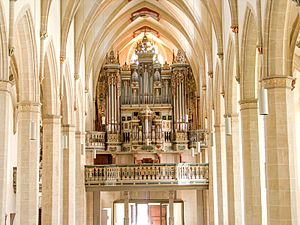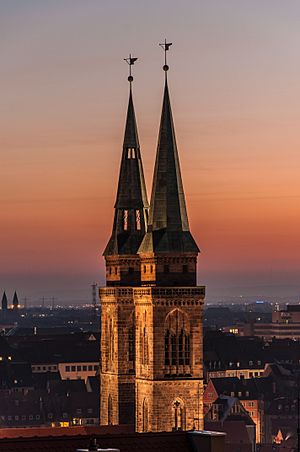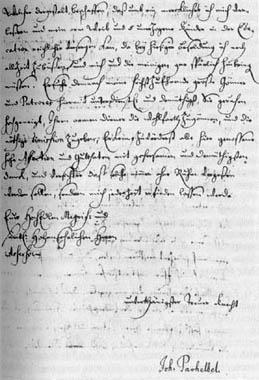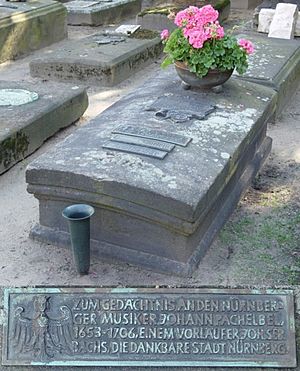Johann Pachelbel facts for kids
Quick facts for kids
Johann Pachelbel
|
|
|---|---|
| Born |
Free Imperial City of Nuremberg
|
| Baptised | 11 September [O.S. 1 September] 1653 |
| Died | before 9 March 1706 (burial) (aged 52) Free Imperial City of Nuremberg
|
|
Works
|
List of compositions |
| Spouse(s) |
Barbara Gabler
(m. 1681; Judith Drommer
(m. 1684) |
| Children | 8, including Wilhelm, Amalia and Charles |
| Signature | |
Johann Pachelbel (baptised 11 September 1653 – buried 9 March 1706) was a famous German composer, organist, and teacher. He was one of the most important composers of the middle Baroque period. This was a time in music history from about 1600 to 1750.
Pachelbel wrote a lot of music, both for churches and for everyday life. His music was very popular when he was alive. Many people learned from him, and his music became a guide for other composers in Germany. Today, Pachelbel is best known for his piece called the Canon in D. Other well-known works include the Chaconne in F minor and the Hexachordum Apollinis.
He was influenced by composers from southern Germany, Italy, and France. Pachelbel liked a clear and simple style in his music. He often used different instruments together in his chamber music (music for small groups) and vocal music (music with singing). He also explored many ways to create variations in his pieces.
Contents
Life of Johann Pachelbel
Early Life and Education (1653–1674)
Johann Pachelbel was born in 1653 in Nuremberg, Germany. His father, Johann Pachelbel, was a wine dealer. We don't know his exact birthday, but he was baptized on 1 September. He had an older brother, Johann Matthäus, who was also a musician.
Young Pachelbel started learning music from Heinrich Schwemmer. Schwemmer later became the music director at St. Sebaldus Church. Pachelbel was very talented in both music and school. He went to school in Nuremberg. In 1669, he started studying at the University of Altdorf. He also became the organist at St. Lorenz church that same year.
Because of money problems, Pachelbel had to leave the university. In 1670, he got a scholarship to study at a school in Regensburg. The school was so impressed by him that they let him in even though they were full. He also got to study music outside of school. His teacher, Kaspar Prentz, taught him about Italian music. This made Pachelbel interested in the church music of that time.
Career in Vienna, Eisenach, and Erfurt (1673–1690)
In 1673, Pachelbel moved to Vienna. He became a deputy organist at Saint Stephen Cathedral. Vienna was a very important city for culture and music. Many famous composers lived there. Pachelbel spent five years in Vienna. He learned a lot from the Catholic composers of southern Germany and Italy. Even though he was Lutheran, Catholic music influenced his work.
In 1677, Pachelbel moved to Eisenach. He worked as a court organist for Duke Johann Georg I. In Eisenach, he met members of the Bach family. This was the hometown of J. S. Bach's father, Johann Ambrosius Bach. Pachelbel became a close friend of Johann Ambrosius. He also taught music to his children.
Pachelbel only stayed in Eisenach for one year. The Duke's brother died, and court musicians were no longer needed. Pachelbel left Eisenach in 1678. His boss wrote a letter saying Pachelbel was a "perfect and rare virtuoso."

In June 1678, Pachelbel became the organist at the Predigerkirche in Erfurt. The Bach family was very well known in Erfurt. Pachelbel's friendship with them continued there. He became the godfather to Johann Ambrosius' daughter. He also taught Johann Christoph Bach, J.S. Bach's older brother.
Pachelbel stayed in Erfurt for 12 years. During this time, he became known as one of Germany's top organ composers. His job required him to write chorale preludes for church services. He also had to compose a big piece of music every year. This was to show how much he was improving.
Pachelbel got married twice in Erfurt. His first wife, Barbara Gabler, and their only son died in 1683 during a plague. This sad event likely influenced his first published work. It was a set of chorale variations called Musicalische Sterbens-Gedancken ("Musical Thoughts on Death").
Ten months later, in 1684, Pachelbel married Judith Drommer. They had five sons and two daughters. Two of their sons, Wilhelm Hieronymus Pachelbel and Charles Theodore Pachelbel, also became organ composers. Charles Theodore later moved to the American colonies. One of his daughters, Amalia Pachelbel, became a recognized painter.
Final Years (1690–1706)
Even though Pachelbel was very successful in Erfurt, he wanted a better job. He left Erfurt in 1690. Soon after, he became an organist at the court in Stuttgart. He only stayed there for two years. He had to leave because of French attacks during the Nine Years' War.
His next job was in Gotha as the town organist, starting in 1692. There, he published his first collection of church music called Acht Chorale zum Praeambulieren.
In 1694, Pachelbel probably attended the wedding of his former student, Johann Christoph Bach. This might have been the only time he met Johann Sebastian Bach, who was nine years old at the time.
In 1695, the organist at St. Sebaldus Church in Nuremberg died. The city leaders really wanted Pachelbel to take the job. They invited him without the usual tests. He accepted and moved back to Nuremberg that summer.
Pachelbel spent the rest of his life in Nuremberg. He published his chamber music collection Musicalische Ergötzung there. He also published Hexachordum Apollinis in 1699. This book had six keyboard pieces with variations. He dedicated it to Dieterich Buxtehude, another famous composer.
Johann Pachelbel died in early March 1706, at age 52. He was buried on 9 March. He is buried in the St. Rochus Cemetery.
Pachelbel's Music
Pachelbel wrote many different kinds of music. He was especially known for his organ music. He wrote over 200 pieces for the organ. He also wrote about 100 pieces for voices, including some large works. Only a few of his chamber music pieces survive.
Keyboard Music
Pachelbel's organ music is often simple. Many pieces, especially his chorale preludes, can be played without using the organ's foot pedals. This was important because people often played these pieces at home on smaller instruments like harpsichords. Organs in southern Germany, where Pachelbel lived, were also generally simpler than those in northern Germany.
Only two of Pachelbel's organ music books were published during his lifetime. One was Musicalische Sterbens-Gedancken (1683), a set of variations. The other was Acht Choräle (1693).
Chorale Preludes
Almost half of Pachelbel's surviving organ works are chorale preludes. These pieces are based on church hymns. Pachelbel often used a special style where a hymn tune is played clearly in one part, while other parts play faster, imitative melodies around it. This became a very common style.
Fugues
Pachelbel wrote over 100 fugues. A fugue is a piece where a short musical idea (called a subject) is introduced and then repeated by different voices. His fugues are usually shorter than later ones, like those by J.S. Bach. Pachelbel was important in developing the fugue form. He was also one of the first major composers to put a fugue together with a prelude or toccata. This idea was later used a lot by J.S. Bach.
Many of his fugues are called Magnificat Fugues. These were likely played during church services. They are usually short and have three voices. Pachelbel used many different musical ideas for his fugues.
Chaconnes and Variations
Pachelbel loved writing music with variations. This can be seen in his chaconnes and sets of arias with variations. A chaconne is a piece built over a repeating bass line. Pachelbel's chaconnes are known for their beautiful melodies. The F minor chaconne is one of his most famous organ works.
In 1699, Pachelbel published Hexachordum Apollinis. This collection has six pieces, each an "aria and variations." The last piece, Aria Sebaldina, is named after the church where he worked. These pieces show many different ways to create variations.
Toccatas
Pachelbel wrote about 20 toccatas. A toccata is a piece that often sounds like a free-flowing improvisation. Pachelbel's toccatas often have fast musical passages played by both hands, while the organ's foot pedals hold long, sustained notes. Unlike other composers, Pachelbel's toccatas usually stick to one main musical idea throughout.
Chamber Music
Pachelbel's chamber music is for small groups of instruments. His most famous piece, the Canon in D, is a chamber music piece. It was originally written for three violins and a basso continuo (a bass instrument and a keyboard). In the Canon, the violins play a repeating melody over a repeating bass line. The violins' parts create 28 variations of the melody. It was originally paired with a gigue, a lively dance piece.
Musicalische Ergötzung ("Musical Delight") is another set of six chamber suites. These were for two violins and basso continuo. They were meant for amateur violinists. Each suite starts with an introductory movement, followed by dance movements.
Vocal Music
Pachelbel also wrote a lot of music for singing. His early vocal works show how skilled he was at writing for large groups of instruments and voices.
His large church pieces, like his Vespers and sacred concertos, are very important. Many of them use a modern style with many instruments. For example, one piece, Jauchzet dem Herrn, alle Welt, uses four trumpets, drums, violins, violas, and other instruments. Pachelbel used a wide range of styles in his vocal music, from psalm settings to chorale concertos.
He also wrote motets and arias. Motets are usually for two choruses singing together. His arias were often written for special events like weddings or birthdays.
Pachelbel's Legacy
Pachelbel was one of the last important composers of the middle Baroque period. He didn't directly influence many of the most famous later Baroque composers like George Frideric Handel. However, he did influence Johann Sebastian Bach indirectly. J.S. Bach's older brother, Johann Christoph, studied with Pachelbel. Bach's early music shows some influence from Pachelbel.
Pachelbel was the last great composer of the Nuremberg music tradition. His influence mostly spread through his students. These included Johann Christoph Bach and his own sons, Wilhelm Hieronymus Pachelbel and Charles Theodore Pachelbel. Charles Theodore was one of the first European composers to live in the American colonies. So, Pachelbel had some indirect influence on early American church music.
After the Baroque style became less popular, many composers from that time were forgotten. But in the 19th century, some of Pachelbel's organ works were published. Researchers began to see how important he was in the history of keyboard music. In the mid-20th century, people became very interested in early Baroque music again. This led to more study and performances of Pachelbel's works.
The Canon in D became hugely popular in the 1970s. A recording in 1968 made it famous around the world. It was also used as the theme music for the film Ordinary People in 1980. Today, it's one of the most recognized Baroque pieces. It's often played at weddings. The chord progression from the Canon has even been used in a lot of pop music in recent times. Some people even call it "almost the godfather of pop music."
See also
 In Spanish: Johann Pachelbel para niños
In Spanish: Johann Pachelbel para niños




